Problem Statement
A robber is targeting to rob houses from a street. Each house has security measures that alert the police when two adjacent houses are robbed. The houses are arranged in a circular manner, thus the first and last houses are adjacent to each other.
Given an integer array money, where money[i] represents the amount of money that can be looted from the (i+1)th house. Return the maximum amount of money that the robber can loot without alerting the police.
Examples
Examples 1:
Input: money = [2, 1, 4, 9]
Output: 10
Explanation: [ , 1, , 9], The house at the index 1 and index 4 is choosen to rob the maximum money.
Note: We cannot loot the 1st and 4th houses together.Example 2:
Input: money = [1, 5, 2, 1, 6]
Output: 11
Explanation: [ , 5, , , 6] The houses at the index 1 and index 4 is choosen to rob the maximum money.Different Approaches
Here, the problem is asking for maximum money the theif can rob, so based on the discussion in previous articles, it is obvious that we think of recursion to solve this problem.
This problem can be tackled using the method outlined in the article on Maximum Sum of non-adjacent elements. It is strongly recommended that readers review that article before proceeding with this one.
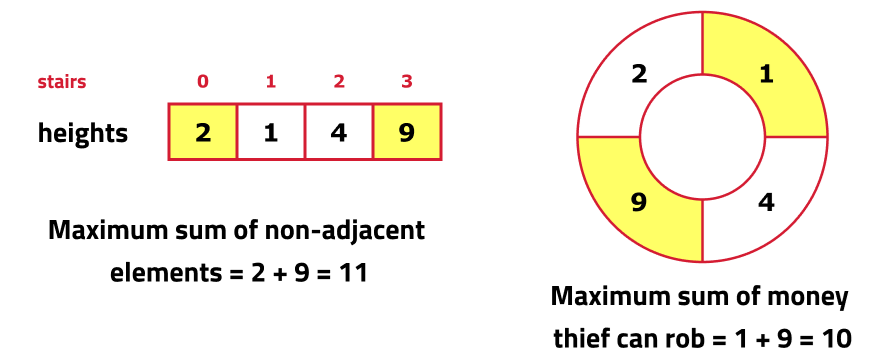
- According to the above example, the maximum sum of non-adjacent elements would be
11, at index0and3. - If the houses are arranged in circular manner, it means the first and last houses are also adjacent to each other. So, the maximum possible answer is 10 from index
1and3.
Modification the the maximum sum of non-adjacent elements:
In previous questions, the focus was on finding the maximum sum of non-adjacent elements. As the arrangement was linear, the first and last elements were not adjacent to each other. In this case of a circular street where the first and last houses are adjacent, it is certain that both cannot be included in the answer simultaneously, as they are adjacent to each other.
- Building upon the previous Article, it can be inferred that the last element may not be included in the optimal solution. In such a scenario, the first element could be considered instead. This resultant answer is denoted as ans1. Therefore, the array is reduced by excluding the last element, forming arr1, and applying the previous approach to find ans1.
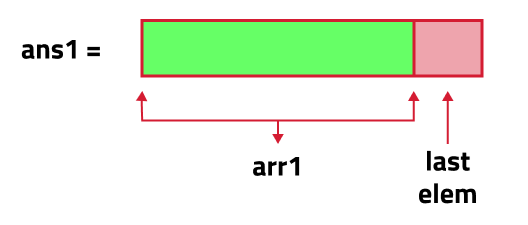
- It is also possible that the final answer includes the last element. In this case, the first element cannot be included (due to adjacency). The same approach is applied to the reduced array (arr - first element), denoted as arr2, to determine the answer, referred to as ans2.
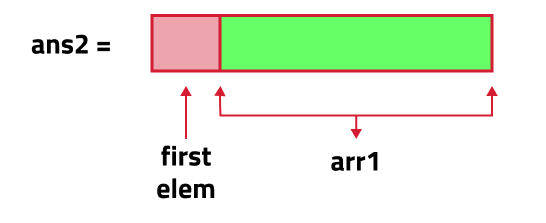
- The final answer can either be ans1 or ans2. To determine the maximum money robbed by the robber, max(ans1, ans2) is returned as the final answer.
Approach to solving the problem:
- Make two reduced arrays: arr1, it has every element except the last one(arr-last element) and arr2, it has every element except the first one(arr-first element). As the first and the last element can't be considered simultaneously in case of circular arrangement.
- Find the sum of maximum of non-adjacent elements: In arr1 and arr2 separately find the maximum sum by using the pick/non-pick method used in previous article. Let’s call the answers we got ans1 and ans2 respectively.
- Return max(ans1, ans2) as our final answer, as the answer requires maximum money.
1️⃣ Recursive Approach
Intuition:
- Represent the function in terms of indices: As the houses are arranged in circular manner, each house can be represented as an index. f(n-1) will return the maximum sum from 0th index till (n-1)th index. Here two separate arrays will be considered and all the following steps will be applied on both of them.
- Try all the choices to reach the goal: As mentioned earlier we will use the pick/non-pick technique to generate all subsequences. In addition to that only pick up the non-adjacent elements in this step.
There are two possible choices that can be made for each index. If we pick an element then, pick = arr[ind] + f(ind-2). The reason we are doing f(ind-2) is because we have picked the current index(ind) element so we need to pick a non-adjacent element so we choose the index ‘ind-2’ instead of ‘ind-1’.
The other choice can be to ignore the current element at index(ind) in our subsequence. So nonPick= 0 + f(ind-1). As we don’t pick the current element, we can consider the adjacent element in the subsequence.
/*It is pseudocode and it is not tied to
any specific programming language*/
f(ind, arr[]){
// base condition here
pick = arr[ind] + find(ind-2, arr)
notPick = 0 + f(ind-1, arr)
}- Take the maximum of all the choices: As the problem statement asks to find the maximum sum, return the maximum of two choices made in the above step.
/*It is pseudocode and it is not tied to
any specific programming language*/
f(ind, arr[]){
// base condition here
pick = arr[ind] + f(ind-2, arr)
notPick = 0 + f(ind - 1, arr)
return max(pick, notPick)
}- Base Conditions:
- If
ind=0, then we know to reach at index=0, we would have ignored the element at index = 1. Therefore, we can simply return the value of arr[ind] and consider it in the subsequence. - If
ind<0, this case can hit when we call f(ind-2) at ind=1. In this case we want to return to the calling function so we simply return 0 so that nothing is added to the subsequence sum.
- If
Code:
#include <bits/stdc++.h>
using namespace std;
class Solution {
private:
//Function to solve the problem using recursion
int func(int ind, vector<int> &arr){
//Base case
if (ind == 0)
return arr[ind];
if (ind < 0)
return 0;
// Choosing the current element
int pick = arr[ind] + func(ind - 2, arr);
// Skipping the current element
int nonPick = 0 + func(ind - 1, arr);
// Return the maximum
return max(pick, nonPick);
}
public:
//Function to find the maximum money robber can rob
int houseRobber(vector<int>& money) {
int n = money.size();
vector<int> arr1;
vector<int> arr2;
//If array has only one element, return that
if(n==1)
return money[0];
for(int i=0; i<n; i++){
/*Store every element in
arr1 except the last element*/
if(i!=n-1) arr1.push_back(money[i]);
/*Store every element in
arr2 except the first element*/
if(i!=0) arr2.push_back(money[i]);
}
// call recursive function on both the arrays.
int ans1 = func(arr1.size()-1, arr1);
int ans2 = func(arr2.size()-1, arr2);
//Return the maximum of an1 and ans2
return max(ans1,ans2);
}
};
int main(){
vector<int> arr{1,5,1,2,6};
//Create an instance of Solution class
Solution sol;
//Print the solution
cout<<sol.houseRobber(arr);
}Complexity Analysis:
- Time Complexity:
O(2^n) + O(2^n), wherenis the given size of array. This is because each call branches into two more calls, leading to an exponential growth in the number of calls and the recursive function is being called twice. - Space Complexity:
O(n) + O(n) + O(n) + O(n). As two additional array is being used and an extra O(n) + O(n) because the maximum depth of the recursion stack can go up ton, and the function is being called twice.
2️⃣ Memoization
If we observe the recursion tree, we will observe a number of overlapping subproblems. Therefore the recursive solution can be memoized to reduce the time complexity.
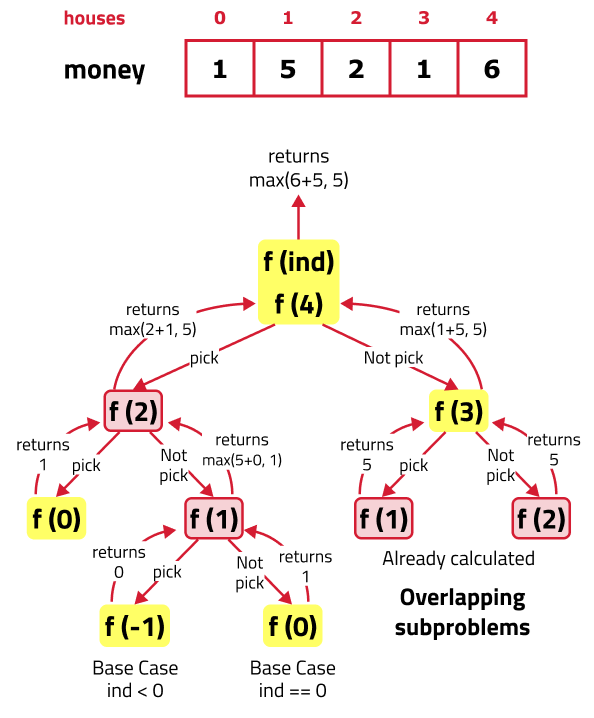
Steps to convert Recursive code to memoization solution:
- Declare an Array dp[] of Size n: Here, n is the size of the given array in the problem, as the highest number of subproblems can be n(including 0 as well). It represents the solution to the subproblem for any given index. Initially, fill the array with -1, to indicate that no subproblem has been solved yet.
- While encountering an overlapping subproblem: When we come across a subproblem, for which the dp array has value other than -1, it means we have found a subproblem which has been solved before hence it is an overlapping subproblem. No need to calculate it's value again just retrieve the value from dp array and return it.
- Store the value of subproblem: Whenever, a subproblem is encountered and it is not solved yet(the value at this index will be -1 in the dp array), store the calculated value of subproblem in the array.
Code:
#include <bits/stdc++.h>
using namespace std;
class Solution {
private:
//Function to solve the problem using recursion
int func(int ind, vector<int> &arr, vector<int> &dp){
//Base case
if (ind == 0)
return arr[ind];
if (ind < 0)
return 0;
if(dp[ind] != -1){
return dp[ind];
}
// Choosing the current element
int pick = arr[ind] + func(ind - 2, arr, dp);
// Skipping the current element
int nonPick = 0 + func(ind - 1, arr, dp);
/* Store the result in dp
array and return the maximum */
return dp[ind] = max(pick, nonPick);
}
public:
//Function to find the maximum money robber can rob
int houseRobber(vector<int>& money) {
int n = money.size();
vector<int> arr1;
vector<int> arr2;
//If array has only one element, return that
if(n==1)
return money[0];
for(int i=0; i<n; i++){
/*Store every element in
arr1 except the last element*/
if(i!=n-1) arr1.push_back(money[i]);
/*Store every element in
arr2 except the first element*/
if(i!=0) arr2.push_back(money[i]);
}
//Initialize the dp array with -1
vector<int> dp(n, -1);
int ans1 = func(arr1.size()-1, arr1, dp);
vector<int> dp1(n, -1);
int ans2 = func(arr2.size()-1, arr2, dp1);
//Return the maximum of an1 and ans2
return max(ans1,ans2);
}
};
int main(){
vector<int> arr{1,5,1,2,6};
//Create an instance of Solution class
Solution sol;
//Print the solution
cout<<sol.houseRobber(arr);
}Complexity Analysis:
- Time Complexity:
O(N) + O(N), whereNis the given size of array. The overlapping subproblems will return the answer in constant time O(1). As total subproblems can be at max N. Therefore it will take O(N) and the function is being called twice. - Space Complexity:
O(N) + O(N) + O(N) + O(N) + O(N) + O(N), Two arrays to store the elements separately are being used. Additionally, two dp arrays and stack space of O(N) is used for two function calls. Therefore the overall space complexity will be ≈ O(N).
3️⃣ Tabulation
In order to convert a recursive code to tabulation code, we try to convert the recursive code to tabulation and here are the steps:
- Declare an Array dp[] of Size n: Here, n is the size of the array provided as input. It represents the solution to the subproblem for any given index.
- Setting Base Cases in the Array: In the recursive code, we knew the answer for base case, when 'ind' = 0, Here, dp[0] is initialized directly to arr[0] because if there is only one element in the array, that element itself is the maximum sum.
- Iterative Computation Using a Loop: Set an iterative loop that traverses the array( from index 1 to n-1). To compute the solution for larger values, use a loop that iterates from the smallest subproblem up to n-1.
- Explanation of dp[i] Calculation: The current value(dp[i]) represents the subproblem and by the recurrence relation it is obvious that dp[i] is calculated by either picking the current element or not picking it (dp[i-2] + arr[i] and dp[i-1]))
- Choosing the maximum: Update dp[i] to store the maximum of these two values pick and nonPick.
- Returning the last element: The last element of the dp array is returned because it holds the optimal solution to the entire problem after the bottom-up computation has been completed.
Code:
#include <bits/stdc++.h>
using namespace std;
class Solution {
private:
//Function to solve the problem using tabulation
int func(vector<int> &nums){
int ind = nums.size();
vector<int> dp(ind, 0);
// Base case
dp[0] = nums[0];
// Iterate through the elements of the array
for (int i = 1; i < ind; i++) {
/* Calculate maximum value by either picking
the current element or not picking it*/
int pick = nums[i];
if (i > 1)
pick += dp[i - 2];
int nonPick = dp[i - 1];
// Store the maximum value in dp array
dp[i] = max(pick, nonPick);
}
/* The last element of the dp array
will contain the maximum sum*/
return dp[ind-1];
}
public:
//Function to find the maximum money robber can rob
int houseRobber(vector<int>& money) {
int n = money.size();
vector<int> arr1;
vector<int> arr2;
//If array has only one element, return that
if(n==1)
return money[0];
for(int i=0; i<n; i++){
/*Store every element in
arr1 except the last element*/
if(i!=n-1) arr1.push_back(money[i]);
/*Store every element in
arr2 except the first element*/
if(i!=0) arr2.push_back(money[i]);
}
int ans1 = func(arr1);
int ans2 = func(arr2);
//Return the maximum of an1 and ans2
return max(ans1,ans2);
}
};
int main(){
vector<int> arr{1,5,1,2,6};
//Create an instance of Solution class
Solution sol;
//Print the solution
cout<<sol.houseRobber(arr);
}Complexity Analysis:
- Time Complexity:
O(n)+O(n), wherenis the given size of array. As each element of the array is processed exactly once in a single pass and the function is being called twice. - Space Complexity:
O(n)+O(n)+O(n)+O(n), As two arrays are used to store elements.O(n)+O(n), an additional dp array is used, which stores results for each element of the array and function is being called twice. So overall time complexity will be O(N).
4️⃣ Space Optimized
If we do some observation, we find that the values required at every iteration for dp[i] are dp[i-1] and dp[i-2]. we see that for any i, we do need only the last two values in the array. So is there is no need to maintain a whole array for it.
Let us call dp[i-1] as prev and dp[i-2] as prev2. Now understand the following illustration:
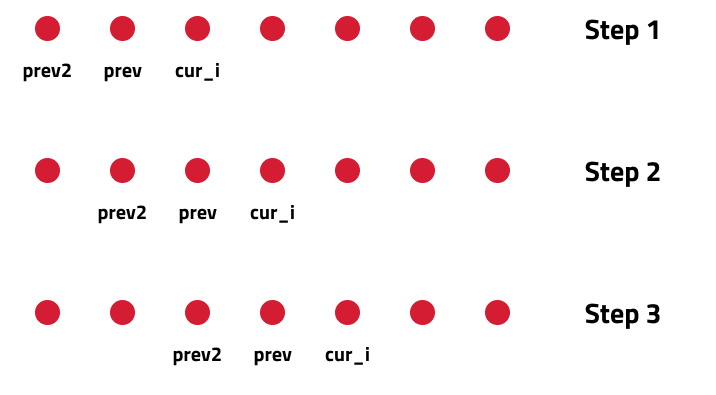
- Each iteration cur_i and prev become the next iteration’s prev and prev2 respectively. Therefore after calculating cur_i, if we update prev and prev2 according to the next step, we will always get the answer.
- After the iterative loop has ended we can simply return prev as our answer. As at the end of the loop prev will contain curr_i, the maximum sum.
Code:
#include <bits/stdc++.h>
using namespace std;
class Solution {
private:
//Function to solve the problem using tabulation
int func(vector<int> &nums){
int n = nums.size();
int prev = nums[0];
int prev2 = 0;
for (int i = 1; i < n; i++) {
// Maximum sum if we pick current element
int pick = nums[i];
if (i > 1){
//Add the maximum sum two elements ago
pick += prev2;
}
// Maximum sum if we don't pick current element
int nonPick = 0 + prev;
// Maximum at the current element
int cur_i = max(pick, nonPick);
prev2 = prev;
prev = cur_i;
}
// Return the maximum sum
return prev;
}
public:
//Function to find the maximum money robber can rob
int houseRobber(vector<int>& money) {
int n = money.size();
vector<int> arr1;
vector<int> arr2;
//If array has only one element, return that
if(n==1)
return money[0];
for(int i=0; i<n; i++){
/*Store every element in
arr1 except the last element*/
if(i!=n-1) arr1.push_back(money[i]);
/*Store every element in
arr2 except the first element*/
if(i!=0) arr2.push_back(money[i]);
}
int ans1 = func(arr1);
int ans2 = func(arr2);
//Return the maximum of an1 and ans2
return max(ans1,ans2);
}
};
int main(){
vector<int> arr{1,5,1,2,6};
//Create an instance of Solution class
Solution sol;
//Print the solution
cout<<sol.houseRobber(arr);
}Complexity Analysis:
- Time Complexity:
O(n)+O(n), wherenis the given size of array. As each element of the array is processed exactly once in a single pass and the array is being called twice. - Space Complexity:
O(n)+O(n), as two additional arrays are used to store the elements.
